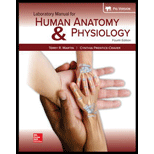
Urine consists of about __________ percent water and __________ percent solutes.
a. 100;0
b. 95;5
c. 90; 10
d. 50; 50
Introduction :
The function of the excretory system is to remove the waste of the body. It maintains the chemical composition of the body fluids by removing the unwanted components and maintaining the level of water and electrolytes in the body. Moreover, the level of water in the body is maintained by the excretory system.
Answer to Problem 1PL
Correct answer :
Option (b), 95, 5.
Explanation of Solution
Explanation/justification for the correct answer :
Option (b) is 95, 5. Urine is composed of 95% water approximately, and the rest 5% is composed of solutes, such as, sodium, urea, potassium, chloride, and creatinine. Hence, this option is correct.
Explanation for incorrect answer :
Option (a) is 100, 0. Urine is composed of 95 percent water and 5 percent solutes. Hence, this option is incorrect.
Option (c) is 90, 10. Urine is composed of 95 percent water and 5 percent solutes. Hence, this option is incorrect.
Option (d) is 50, 50. Urine is composed of 95 percent water and 5 percent solutes. Hence, this option is incorrect.
Option (b), 95, 5.
Want to see more full solutions like this?
Chapter 58 Solutions
Laboratory Manual For Human Anatomy & Physiology
- please draw in the answers, thank youarrow_forwarda. On this first grid, assume that the DNA and RNA templates are read left to right. DNA DNA mRNA codon tRNA anticodon polypeptide _strand strand C с A T G A U G C A TRP b. Now do this AGAIN assuming that the DNA and RNA templates are read right to left. DNA DNA strand strand C mRNA codon tRNA anticodon polypeptide 0 A T G A U G с A TRParrow_forwardplease answer all question below with the following answer choice, thank you!arrow_forward
- please draw in the answeres, thank youarrow_forwardA) What is being shown here?B) What is indicated by the RED arrow?C) What is indicated by the BLUE arrow?arrow_forwardPlease identify the curve shown below. What does this curve represent? Please identify A, B, C, D, and E (the orange oval). What is occurring in these regions?arrow_forward
- Please identify the test shown here. 1) What is the test? 2) What does the test indicate? How is it performed? What is CX? 3) Why might the test be performed in a clinical setting? GEN CZ CX CPZ PTZ CACarrow_forwardDetermine how much ATP would a cell produce when using fermentation of a 50 mM glucose solution?arrow_forwardDetermine how much ATP would a cell produce when using aerobic respiration of a 7 mM glucose solution?arrow_forward
- Determine how much ATP would a cell produce when using aerobic respiration to degrade one small protein molecule into 12 molecules of malic acid, how many ATP would that cell make? Malic acid is an intermediate in the Krebs cycle. Assume there is no other carbon source and no acetyl-CoA.arrow_forwardIdentify each of the major endocrine glandsarrow_forwardCome up with a few questions and answers for umbrella species, keystone species, redunant species, and aquatic keystone speciesarrow_forward
 Comprehensive Medical Assisting: Administrative a...NursingISBN:9781305964792Author:Wilburta Q. Lindh, Carol D. Tamparo, Barbara M. Dahl, Julie Morris, Cindy CorreaPublisher:Cengage Learning
Comprehensive Medical Assisting: Administrative a...NursingISBN:9781305964792Author:Wilburta Q. Lindh, Carol D. Tamparo, Barbara M. Dahl, Julie Morris, Cindy CorreaPublisher:Cengage Learning





